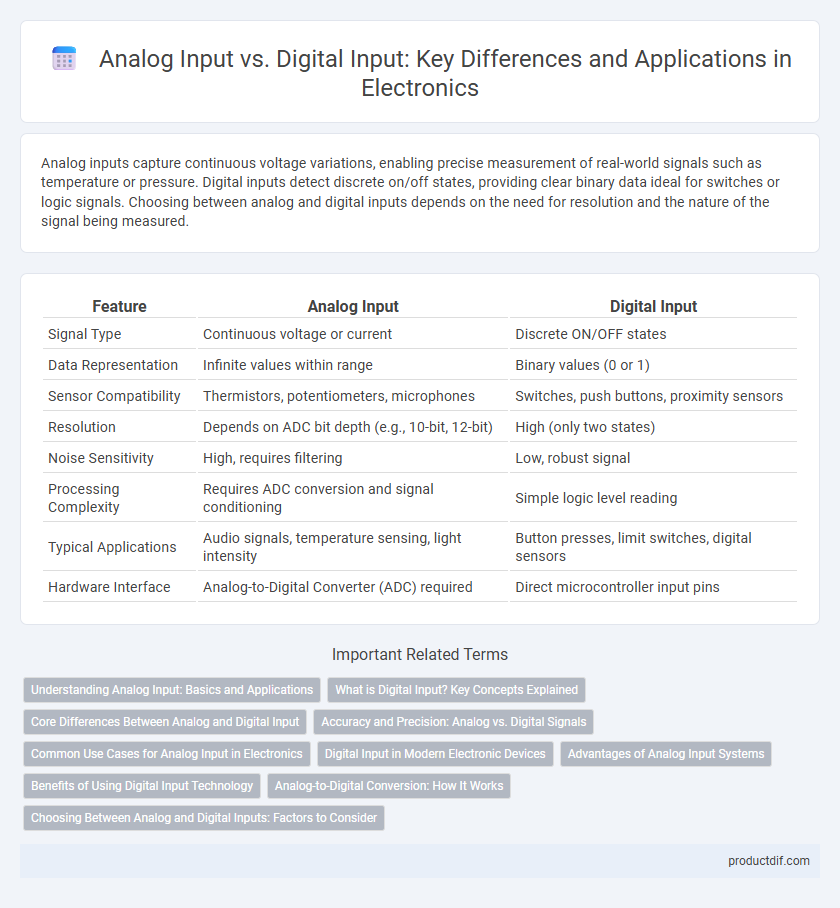Analog inputs capture continuous voltage variations, enabling precise measurement of real-world signals such as temperature or pressure. Digital inputs detect discrete on/off states, providing clear binary data ideal for switches or logic signals. Choosing between analog and digital inputs depends on the need for resolution and the nature of the signal being measured.
Table of Comparison
| Feature | Analog Input | Digital Input |
|---|---|---|
| Signal Type | Continuous voltage or current | Discrete ON/OFF states |
| Data Representation | Infinite values within range | Binary values (0 or 1) |
| Sensor Compatibility | Thermistors, potentiometers, microphones | Switches, push buttons, proximity sensors |
| Resolution | Depends on ADC bit depth (e.g., 10-bit, 12-bit) | High (only two states) |
| Noise Sensitivity | High, requires filtering | Low, robust signal |
| Processing Complexity | Requires ADC conversion and signal conditioning | Simple logic level reading |
| Typical Applications | Audio signals, temperature sensing, light intensity | Button presses, limit switches, digital sensors |
| Hardware Interface | Analog-to-Digital Converter (ADC) required | Direct microcontroller input pins |
Understanding Analog Input: Basics and Applications
Analog input involves capturing continuous signals that vary over time, such as voltage or current, allowing precise measurement of real-world phenomena like temperature, pressure, or sound. Unlike digital input, which interprets binary signals as discrete values, analog input provides fluctuating data that require analog-to-digital converters (ADCs) for processing by microcontrollers or digital systems. Common applications of analog input include sensor data acquisition, audio signal processing, and instrumentation, where accurate representation of signal amplitude is crucial.
What is Digital Input? Key Concepts Explained
Digital input refers to an electrical signal that represents data as discrete binary states, typically logic high (1) or logic low (0), enabling devices to interpret on/off or true/false conditions. Unlike analog input, which captures continuous voltage variations, digital input simplifies signal processing by providing clear, unambiguous values, essential for microcontrollers, digital circuits, and automated control systems. Key concepts include voltage thresholds defining logic levels, debounce handling to stabilize mechanical switch inputs, and compatibility with digital communication protocols like I2C or SPI.
Core Differences Between Analog and Digital Input
Analog input continuously varies within a range, capturing real-world signals such as temperature, sound, or light intensity with infinite resolution. Digital input represents data only in discrete binary states, typically as 0s and 1s, providing clear, noise-resistant signals ideal for logic-based systems. The core difference lies in analog inputs conveying variable magnitude values, whereas digital inputs deliver specific, distinct levels.
Accuracy and Precision: Analog vs. Digital Signals
Analog inputs provide continuous signals representing real-world variables with high precision, enabling fine granularity in measurements. Digital inputs convert signals into discrete binary values, which can limit resolution but offer increased noise immunity and consistency. The accuracy of analog signals depends heavily on sensor quality and signal conditioning, while digital signals rely on resolution of analog-to-digital converters for precision.
Common Use Cases for Analog Input in Electronics
Analog inputs are widely used in electronics for measuring continuous physical variables such as temperature, pressure, and light intensity, enabling precise monitoring and control in systems like thermostats, industrial sensors, and medical devices. These inputs convert real-world signals into varying voltage or current levels that can be processed by microcontrollers or data acquisition systems. Common applications include environmental sensing, audio signal processing, and instrumentation where accuracy and resolution of analog data are critical.
Digital Input in Modern Electronic Devices
Digital input in modern electronic devices enables precise and noise-resistant data processing by converting physical signals into binary values, ensuring compatibility with microcontrollers and digital circuits. The use of digital input improves system reliability and supports complex functionalities such as real-time data acquisition and automation. Advanced sensors and input modules rely on digital input interfaces to enhance performance, accuracy, and integration within smart electronics ecosystems.
Advantages of Analog Input Systems
Analog input systems offer superior resolution and accuracy by capturing continuous signals that reflect real-world variations more precisely than digital inputs. These systems enable real-time monitoring and control of variables such as temperature, pressure, and voltage with finer granularity, facilitating better decision-making in applications like industrial automation and instrumentation. Unlike digital inputs, analog inputs provide a more detailed representation of sensor data, leading to improved system performance and enhanced diagnostic capabilities.
Benefits of Using Digital Input Technology
Digital input technology provides enhanced noise immunity, ensuring more accurate signal processing in electronics systems. It simplifies circuit design by reducing the number of components required, which increases reliability and lowers production costs. Improved data integration with microcontrollers and digital systems enables faster and more efficient communication and control.
Analog-to-Digital Conversion: How It Works
Analog-to-digital conversion transforms continuous analog signals into discrete digital values using sampling and quantization techniques, enabling microcontrollers to process real-world inputs such as temperature, light, and sound. The accuracy of this conversion depends on the resolution of the analog-to-digital converter (ADC), typically measured in bits, which determines the number of possible output levels. Sampling frequency must be carefully selected to capture signal details without introducing aliasing, following the Nyquist theorem for optimal digital representation.
Choosing Between Analog and Digital Inputs: Factors to Consider
Choosing between analog and digital inputs depends on the nature of the signal and the application requirements. Analog inputs provide continuous, variable voltage or current signals ideal for precise measurements of temperature, pressure, or sound, while digital inputs offer discrete on/off states perfect for binary conditions like switches or logic gates. Consider factors such as signal resolution, noise susceptibility, and required processing complexity when selecting the appropriate input type for electronic systems.
Analog Input vs Digital Input Infographic

 productdif.com
productdif.com